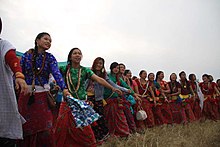सुनुवार

Kirati Sunuwar
|
|
| Total population | |
|---|---|
| Approximately 100,000 (2012 estimate) | |
| Languages | |
| Sunuwar, Nepali | |
| Religion | |
|
Predominantly Kiranti, Hinduism, Buddhism |
Predominantly Kiranti, Hinduism, Buddhism
The Sunuwar (Nepali: Sunuwār Jāti) is an indigenous tribe from Nepal and some areas of India. The majority of this tribe follow the Kirant religion and adopt the Mundhum (Kiranti) culture. They speak the Sunuwar language. Hinduism and Christianity also have some influence. According to the 2001 census of Nepal, only 17.4% were Kirant.
The Kiranti-Kõinchs number 96,254. The term ‘Kõinchs’ is also the name of the mother tongue. Other terms like Mukhiya or Mukhia are exonyms of the tribe. There is another common teasing name (mainly given by outsiders) of the tribe coined from the Sunuwar language itself, e.g. Maaraapaache (lexically maar ‘what’ and patsaa ‘to do’, from when the speakers ask themselves maar patsaa? when in a dilemma). Sunuwar have their distinct language, religion, culture and social customs.
They inhabit the eastern hills of Nepal and Himalayan Indina. They are concentrated along the Molung Khola, Likhu Khola and Khimti Khola (‘Khola’ Indo-Aryan Nepali etymon ‘rivulet’) regions. By administrative division, they dwell in Okhaldhunga, Ramechhap and Dolakha districts of Nepal, politically known as Wallo (‘Near/Hither’), Kirant (in the past and also in use among the Kirantis at present) after the fall of the Kirant dynasty (ruling for about 1903 years and 8 months) at the ancient Nepal valley. Wallo Kirant in the past was their Kipat or communal land. Their migration (mainly to the east) later took place in several parts of the country in Jhapa, Ilam, Panchthar, Taplejung, Terathum, Sunsari, Sindhuli, Kathmandu and other districts and abroad to places such as Darjeeling, Sikkim, Japan, Bhutan, South Korea, the United Kingdom, the United States, and Canada.
...
Wikipedia
